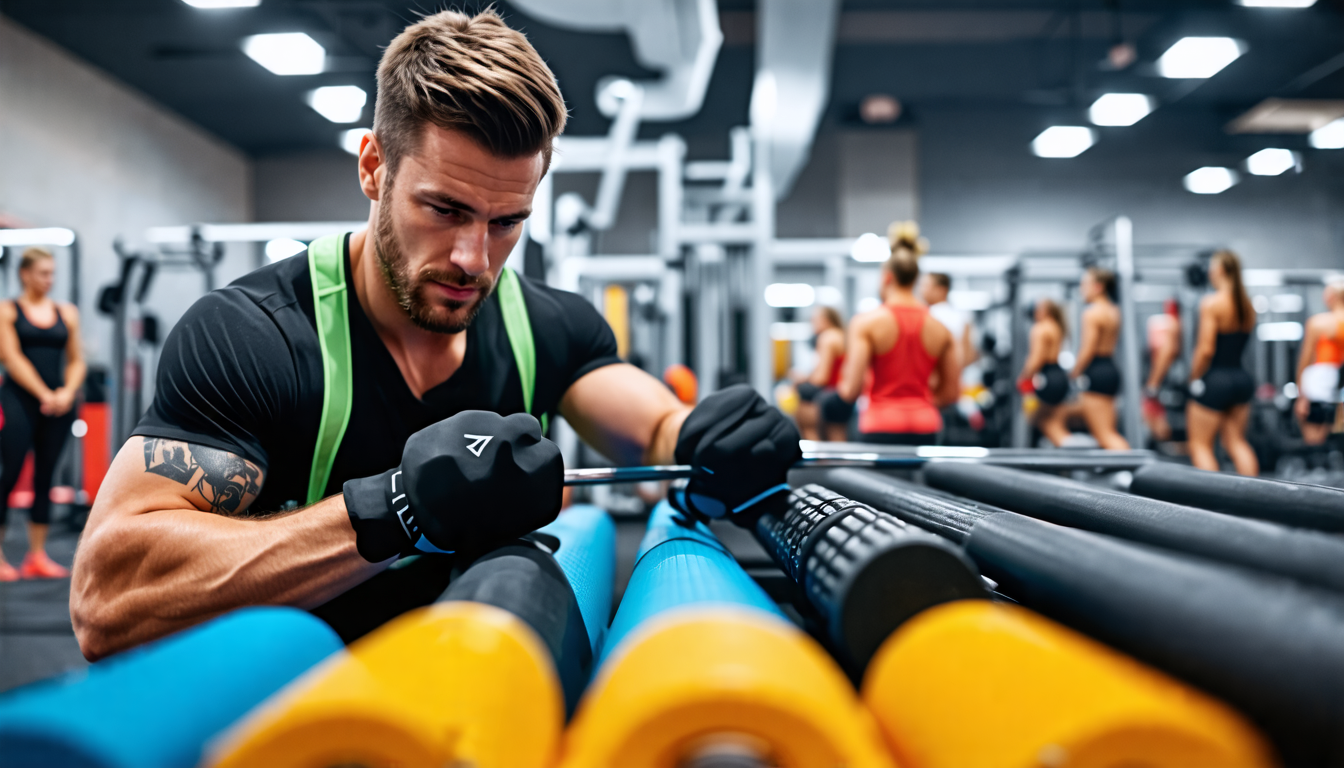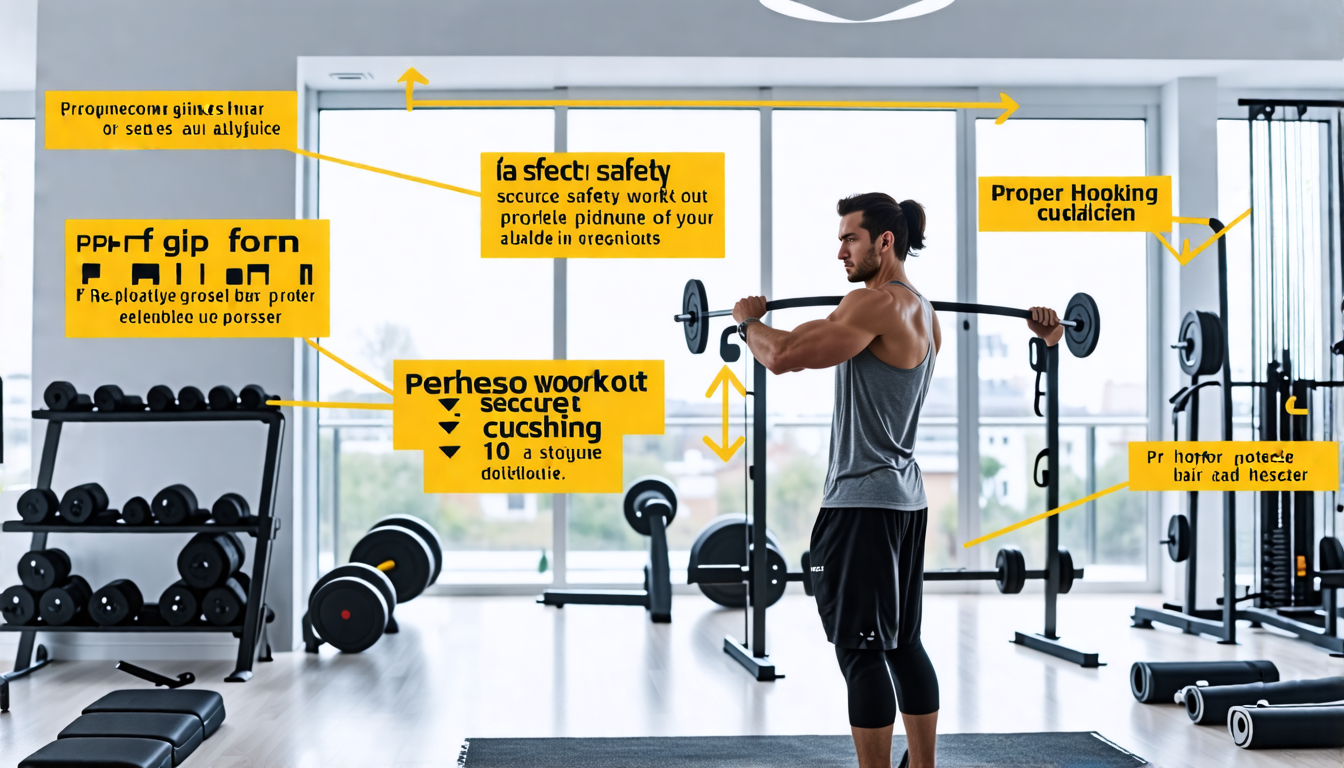When it comes to maintaining an effective and safe home workout routine, the fitness bar is an essential piece of equipment offering versatility and numerous exercise options. However, as with any fitness gear, ensuring safe use is critical to preventing injuries and maximizing the benefits of your workout. Understanding how to properly handle a fitness bar starts with mastering the correct form and techniques for various exercises, which is foundational in minimizing injury risks. This article will guide you step-by-step in executing common fitness bar exercises safely, with a focus on highlighting typical mistakes and providing practical tips to avoid them. Furthermore, it covers the importance of selecting the right type of fitness bar suitable for your specific exercise routine, understanding how vital warm-ups and cool-downs are to your workout regimen, and the significant role that stretching plays in injury prevention. To complement these practices, supportive gear such as gloves, wrist wraps, and belts can further enhance safety and confidence during workouts. By integrating these essential safety tips and correctly using your fitness bar, you can effectively prevent injuries and maintain a robust and healthy exercise routine at home.
Understanding Proper Form and Techniques to Minimize Injury Risks
Importance of learning the right form for different exercises with a fitness bar
Utilizing a fitness bar in your home exercise routine can be an effective way to build strength, improve endurance, and enhance your overall physical health. However, to gain these benefits without the risk of injury, it’s crucial to understand the proper form and techniques involved in each exercise. Proper form ensures that the targeted muscle groups are engaged effectively while minimizing unnecessary strain on the joints and ligaments. Adopting the correct posture and techniques while using a fitness bar can also significantly reduce the risk of common injuries like muscle strains, joint dislocations, or even more severe setbacks such as tendon ruptures.
Proper form does not only prevent injuries but also maximizes the efficiency of your workouts. By maintaining the correct posture, every repetition becomes more effective, allowing you to reach your fitness goals more swiftly. This is particularly important in a home fitness setting where supervision from fitness professionals might not be readily available. Learning and understanding the correct techniques empower you to perform exercises safely and confidently with your fitness bar.
Step-by-step guide on how to execute common fitness bar exercises safely
- Squats: Stand with your feet shoulder-width apart, holding the fitness bar across your upper back. Keep your back straight and your core engaged. Lower your body by bending your knees and pushing your hips back, as if sitting on a chair. Ensure your knees are aligned with your toes and avoid leaning too far forward. Return to the starting position by pushing through your heels.
- Overhead Press: Start by standing with your feet hip-width apart and hold the fitness bar at shoulder height with an overhand grip. Engage your core for stability. Press the bar upwards until your arms are fully extended above your head. Avoid arching your back by keeping your core tight. Lower the bar back to the starting position slowly.
- Deadlifts: Position your feet under the bar, shoulder-width apart. Bend your hips and knees to grasp the bar with an overhand grip. Your chest should be up, and your back should be straight. Lift the bar by extending your hips and knees until you are standing straight. Reverse the motion to lower the bar back to the ground, maintaining a straight back throughout.
- Bent-over Rows: Stand with your feet hip-width apart and bend your knees slightly. Hold the fitness bar with an overhand grip and lean forward from your hips, maintaining a straight back. Pull the bar towards your lower ribcage, squeezing your shoulder blades together. Lower the bar back to the starting position while controlling the movement.
These step-by-step guides ensure you are executing each movement with precision, minimizing the risk of injury while using the fitness bar. Make sure you practice these techniques with lighter weights before moving onto heavier loads, which is particularly important in a home setting where space might be limited, and distractions can occur.
Highlight common mistakes and how to avoid them
- Improper Back Alignment: One of the most frequent mistakes when using a fitness bar is improper spine alignment. This can lead to back injuries. Maintain a neutral spine position by looking forward and keeping your chest up to ensure proper alignment.
- Overextending Joints: Overextension, especially during lifts like the overhead press, can strain joints and muscles. Opt for controlled, smooth movements and focus on form rather than the amount of weight lifted.
- Lack of Engagement: Not engaging your core can affect balance and posture during exercises. Keep your core activated to stabilize your body and prevent stress on your lower back.
- Incorrect Grip: A poor grip can lead to accidents. Make sure your wrists are stable and your grip is firm on the fitness bar. Wrist wraps can help maintain grip stability if necessary.
- Skipping Warm-ups: Skipping warm-ups before using the fitness bar can increase the risk of strains. Always begin your routine with a proper warm-up to prepare your muscles and joints for the workout ahead.
By being aware of these common mistakes and actively working to correct them, you’ll create a safer and more productive home fitness environment. It is also beneficial to occasionally have a fitness professional or experienced friend assess your form to ensure you’re practicing the right techniques with your fitness bar.

Essential Safety Tips and Equipment for Injury Prevention
Choose the Right Fitness Bar: Differences Between Types and Their Suitability for Exercises
Choosing the appropriate fitness bar is crucial for preventing injuries during your home workouts. Fitness bars come in various types, each tailored for specific exercises and fitness levels. Understanding the differences between these bars can help in making an informed decision that aligns with your workout needs and safety considerations.
Firstly, the standard barbell is perfect for beginners engaging in basic strength training exercises like bicep curls or overhead presses. These bars are typically shorter and lighter, making them less intimidating and easier to handle for those new to home fitness.
Second, the Olympic barbell is widely used in professional settings and for advanced exercises such as deadlifts, squats, and bench presses. They are longer and heavier, designed to handle larger weights, and are ideal for athletes looking to take their performance to the next level. Opting for an Olympic barbell ensures enhanced durability and weight capacity but may not be necessary for beginners.
If your home workout involves cross-training or functional exercises, then the multi-purpose bar, such as a trap bar or hex bar, offers a versatile option for reducing strain on the spine and improving lifting posture, crucial for injury prevention.
The Role of Warm-Ups, Cool-Downs, and Stretching in Preventing Injuries
In addition to selecting the right fitness bar, incorporating proper warm-ups, cool-downs, and stretching into your routine is vital for injury prevention. These elements are often overlooked, especially by home fitness enthusiasts eager to jump straight into rigorous bar workouts.
Warm-ups prepare your muscles, joints, and cardiovascular system for the demands of exercising, reducing the risk of strains or sprains. A proper warm-up should last about 5-10 minutes and gradually increase in intensity to elevate your heart rate and enhance circulation. Activities such as light jogging, jumping jacks, or dynamic stretches can significantly improve flexibility and readiness for your fitness bar routine.
Cool-downs are just as important as warm-ups and should not be skipped. They help the body transition back to a resting state, allowing the heart rate to normalize and preventing potential injuries from sudden post-exercise cessation. Cool-down exercises might involve gentle stretching or yoga poses that promote muscle relaxation and help maintain flexibility.
Lastly, integrating a consistent pattern of static stretching at the end of your workout aids in muscle recovery and injury prevention. Focus on stretches targeting the specific muscle groups engaged with the fitness bar, such as the hamstrings, quadriceps, shoulders, and back.
Use of Supportive Gear: Gloves, Wrist Wraps, and Belts for Enhanced Safety
Incorporating supportive gear can significantly contribute to injury prevention while using a fitness bar in your home gym. These accessories enhance grip, provide stability, and support areas vulnerable to strain during intense training sessions.
Gloves are especially useful for improving grip when performing exercises like pull-ups, deadlifts, or bench presses. A secure grip reduces the risk of the bar slipping, decreases the chance of forming calluses, and offers comfort, allowing for a more effective workout without distraction.
Wrist wraps provide critical support for the wrists during heavy lifting and overhead exercises. They stabilize the wrist joints, reducing the likelihood of hyperextension and related injuries. This is particularly beneficial for exercises where wrist stability is crucial, such as cleans or snatches.
Lastly, consider using a weightlifting belt when lifting heavy loads with a fitness bar. A belt offers additional support to the lower back and abdomen, minimizing the risk of injury during exercises that engage the core and lower back, such as squats and deadlifts. It’s important, however, to ensure that belts are not over-relied upon and that proper lifting techniques remain a priority in your training regimen.
Altogether, these safety tips and supportive gear can drastically lower the risk of injuries in your home fitness routine, allowing for effective and safe improvement of your strength and endurance with the use of a fitness bar.
In conclusion, preventing injuries while using a fitness bar is fundamentally about understanding and executing proper form and technique. This approach not only ensures safety but also maximizes the effectiveness of your workout. By committing to learn the right form for a variety of exercises, and carefully heeding the step-by-step guidelines, you’ll minimize risks associated with using a fitness bar. Being aware of and correcting common mistakes can significantly enhance your safety and performance.
Equally important are the essential safety tips and equipment that play a supportive role in injury prevention. Selecting the right type of fitness bar that suits the specific exercises you wish to perform is paramount, as not all bars are created equal. Incorporating comprehensive warm-up, cool-down, and stretching routines prepares your body for the physical demands ahead and aids in recovery after the workout, further reducing the chance of injury. Donning supportive gear such as gloves, wrist wraps, and belts provides additional protection and stability, allowing you to focus more on your form and less on discomfort or potential strain.
For those setting up a home fitness area, this information is particularly critical. Home fitness bars can be an excellent investment for a personalized workout experience, provided you use them safely. By integrating these practices and insights into your fitness routine, you can enjoy the benefits of a home gym without the drawbacks of injury, ensuring long-term health and consistency in your fitness journey. With awareness and preparation, a fitness bar can be a safe and powerful tool for achieving your exercise goals.

